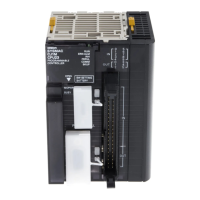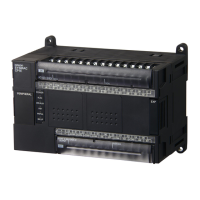rea 2
(4) Size
(Same as (4).)
No. Item Description of function
(1) Area and Start Word
for Area 1
Set the area and the start data link word
to use for area 1.
(2) Size of Area 1 Set the send size per node for area 1.
(3) Area and Start Word
for Area 2
Set the area and the start data link word
to use for area 2.
(4) Size of Area 2 Set the send size per node for area 2.
(5) Nodes Set the nodes to participate in the data
links.
(6) Status start word Set the first word to store data link status.
(If 0 words is set, the default area will be
used.)
Features of Equality Layout
•
The send data sizes is the same for all nodes for each area.
•
Area 1 is selected from the bit-access areas (e.g., CIO Area) and area 2 is
selected from word-access areas (e.g., DM Area).
•
Data link areas are allocated in ascending order of node addresses.
•
Data link participation can be specified for each node.
•
The same data link areas are shared by all nodes participating in the data links.
• Common Type
(2)
(3)
(5)
(6)
(8)
(7)
(1)
(4)
No. Item Description of function
(1) Area and Start Word
for Area 1
Set the area and the start data link word
to use for area 1.
(2) Master size Set the area 1 send size for the master
node.
(3) Slave size Set the area 1 send size for the slave
node.
(4) Area and Start Word
for Area 2
Set the area and the start data link word
to use for area 2.
(5) Master size Set the area 2 send size for the master
node.
(6) Slave size Set the area 2 send size for the slave
node.
(7) Nodes Set the nodes to participate in the data
links.
(8) Status start word Set the first word to store data link status.
(If 0 words is set, the default area will be
used.)
Area 1
1
4
1
2 2
3
1 1
3 4
Area 2
1
4
1
2 2
3
1 1
3 4
Master node Slave node
(7) Participating nodes
Area 1
(1) Area and Start Word
Area 2
(4) Area and Start Word
(2) Master size
(3) Slave size
(Same as (3).)
(Same as (3).)
(5) Master size
(6) Slave size
(Same as (6).)
(Same as (6).)
Features of Common Type 1:N Allocation
•
Data communications are 1:1 between the master node and slave nodes.
•
All slave nodes receive the data sent by the master node.
•
The master node receives all data sent by the slaves. The reception siz
slave nodes.
•
Slaves do not send or receive data with other slaves.
•
Area 1 is selected from the bit-access areas (e.g., CIO Area) and area 2 is
selected from word-access areas (e.g., DM Area).
•
Data link areas are allocated in ascending order of node addresses.
•
Data link participation can be specified for each node.
•
The same area classification can be used for both Area 1 and Area 2,
provided that the same addresses are not used (CS/CJ-series Controlle
